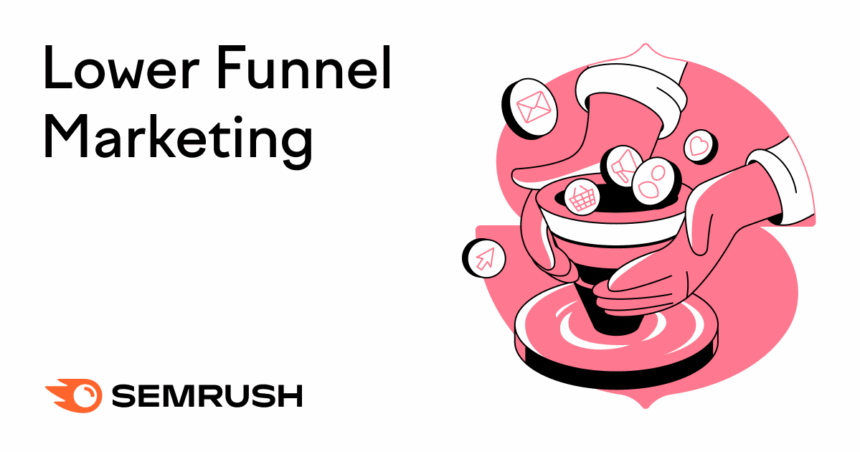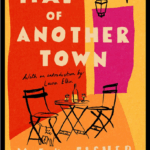What Is Lower-Funnel Marketing?
Lower-funnel marketing is the set of tactics used to persuade prospects nearing the end of their purchase journey to become customers.
It sits at the bottom of the marketing funnel—a model that shows how people go from discovering a brand to making a purchase.
Here’s a breakdown of the funnel stages:
- Top of the funnel: Prospects realize they have a problem and discover brands, products, or services that address it. Educational articles, videos, and awareness campaigns work well at this stage.
- Middle of the funnel: Prospects explore different types of solutions and options. Webinars, comparison content, and lead magnets help nurture and build trust at this stage.
- Bottom of the funnel: Prospects decide what to buy. Free trials, case studies, testimonials, and limited-time deals help convert interest into action at the bottom of the funnel.

Lower-funnel marketing primarily supports the last step of the funnel. It’s focused on helping people choose your solution over others.
8 Effective Lower-Funnel Marketing Tactics
The best bottom-of-the-funnel marketing tactics turn interested prospects into customers. Here are eight of them:
1. Create Conversion-Focused Content
Creating conversion-oriented content gives prospects the information and reassurance they need to take the next steps.
At this stage, content should remove doubts, reinforce the value of your product or service, and ultimately persuade prospects to take action.
Think landing pages, product comparisons, FAQs, pricing pages, case studies, and in-depth demos.
For example, AWeber has a dedicated comparison page to help potential customers understand how it stacks against Mailchimp.
The page includes details about features, trust-building elements like customer quotes, and multiple CTAs—each leading to the same conversion goal: Try AWeber.

To create content like this, build a page that highlights your core offer, answers key questions, and gives visitors a clear next step. Whether that’s starting a free trial, booking a demo, or making a purchase.
Create high-converting landing pages using the Landing Page Builder app. Which offers ready-to-use templates and a drag-and-drop editor.

2. Retarget Visitors with Ads
Retargeting ads put you in front of people who’ve already visited your website or interacted with you on your site or social media but haven’t made a purchase.
These ads can appear when those users visit other websites, browse social media, or use search engines.
Let’s say someone views running shoes on your website but leaves without buying.
You can retarget that visitor by running ads that show the same shoes through ad networks. To provide a gentle reminder that may bring them back to complete their purchase.
Here’s an example of an ad that cookware brand Made In shows to visitors who previously visited the website but didn’t buy:

To run retargeting ads, you need to add a tracking code to your website—usually in the
section. Which lets ad platforms track who visits your pages and which actions they complete.
You can then use platforms like Google Ads and Meta (Facebook and Instagram) to retarget users.
3. Send Personalized Promotional Emails
Sending personalized emails that are tailored to recipients’ behaviors, preferences, demographics, or personal information makes the messages feel more relevant. And recipients may be more likely to respond and buy as a result.
You might highlight products they viewed, recommend items based on past purchases, or offer a small discount to bring them back.
Here’s an example of a wine brand sending a promotional email that’s personalized based on the recipient’s browsing history:

To send personalized promotional emails, start by segmenting your email list.
For example, you can focus on people who viewed a product but didn’t complete a purchase.
Then add dynamic fields to auto-fill details about the recipient. Like their name, company, etc.
Email platforms like Mailchimp and Kit have built-in personalization capabilities to streamline this process.
4. Offer Product Demos or Free Trials
Providing the option to demo your product or claim a free trial lets prospects walk through key features to remove any last-minute doubts that may prevent them from buying.
This is important because prospects want to see exactly how your product or service works when they’re at the bottom of the funnel.
For example, many SaaS products offer free trials. Including Semrush.

We also offer free personalized demos.

When deciding what to offer, consider what’s most feasible for your business.
- A free trial works well if users can automatically create an account and explore features on their own
- A live demo might be better if your product or service requires detailed guidance
Highlight the offer on your homepage, comparison pages, emails, and even ads.
5. Target Transactional and Commercial Keywords
Targeting the right keywords helps you reach people who are actively shopping or comparing solutions, which increases the chances they’ll convert.
There are two main types of keywords to focus on:
- Commercial intent keywords: These are used earlier in the decision process, when people are researching and comparing options. Like “best crm for small teams” or “clickup vs asana.”
- Transactional intent keywords: These are used when someone is ready to take action. Like “buy crm software,” “get crm quote,” or “free crm trial.”
Start with Google’s Keyword Planner to identify these keywords.
Enter a term related to the product or service you offer, then review the results to find terms that include words like “price,” “trial,” “vs,” or “best.”
These usually show that someone is close to making a decision.

For more personalized insights, use Semrush’s Keyword Magic Tool.
Open the tool, enter a broad term related to your business, add your domain, and click “Search.”

Then, filter the keywords by selecting the “Intent” drop-down, checking the boxes next to “Commercial” and “Transactional,” and clicking “Apply.”

You’ll see a list of keyword ideas.
Look for terms with good search volume (meaning a decently high number of monthly searches) and low Personal Keyword Difficulty (a metric that indicates how difficult it will be for your exact website to rank for a term).
These terms are easier to rank for but still likely to attract a reasonable number of visitors.

6. Showcase Customer Reviews and Success Stories
Social proof in the form of reviews, testimonials, and case studies can give potential buyers the reassurance they need to make a decision because it shows that others like them have had good experiences.
Here’s how Asana uses customer stories on its homepage:

To gather social proof, start by reaching out to happy customers. Ask for a short testimonial or to turn their experience into a case study.
You can also encourage reviews through follow-up emails. Or by adding review prompts across your site.
Use the reviews and testimonials you receive on product pages, landing pages, comparison pages, and even in sales emails. Or anywhere a prospect might hesitate before taking action.
7. Use Limited-Time Offers
Limited-time offers and incentives create urgency and encourage prospects to make quicker decisions.
Think of it this way:
When someone is already considering a purchase, a time-sensitive deal—like free shipping, a bonus gift, or a small discount—can push them to act immediately.
Here’s an example of a limited-time discount email from Ray-Ban:

Start by identifying the key moments when buyers tend to hesitate. Like on product pages or after adding an item to their cart.
Add urgency with limited-time banners, countdowns, or email reminders tied to the offer.
Many brands also combine these deals with retargeting ads, reminding past visitors of the deadline and giving them an extra reason to return and buy.
8. Add Live Chat Functionality to Your Site
Having a live chat option on your website helps you answer last-minute questions from potential buyers and remove purchase barriers in real time.
Even small doubts—like whether a plan includes certain features, how billing works, or when an item will ship—can delay a purchase.
Here’s an example of a live chat option on CrowdStrike’s site:

There are many live chat options like Intercom, Tidio, and LiveChat that you can use.
You can manage conversations manually if you have the staff to support it. Or use rule-based or AI-powered chatbots to handle questions automatically.
Place the chat functionality on high-intent pages (like product or pricing pages) to catch users right when they’re likely to need support.
Lower-Funnel Marketing Example: A Deep Dive
Asana—a popular work management platform—is a great example of a company that does bottom-of-the-funnel marketing well.
It ranks in the top 10 Google search results for nearly 8,000 commercial and transactional, according to Semrush’s Organic Research tool.

As you can see, the site ranks for competitive phrases with a strong intent to buy or compare.

One of Asana’s high-ranking pages is a comparison against Monday. Which appears in the top 10 results for the keyword “asana vs monday.”

The page highlights clear feature differences and positions Asana as the more complete solution.
It includes multiple CTAs encouraging users to make a decision to try the platform for free.

Beyond publishing comparison pages, Asana allows visitors to look for information based on company type, team, industry, and use case.
This helps high-intent visitors quickly find the most relevant information based on their specific role or situation.

Asana’s pages also convert well.
According to Semrush’s Traffic Analytics tool, Asana consistently outperforms several of its top competitors in estimated purchase conversions—a metric that reflects the percentage of sessions resulting in a transaction or sign-up.

Clearly, Asana’s lower-funnel efforts help ready-to-buy visitors find what they need to make a choice.
Improve Your Lower-Funnel Marketing Efforts
An effective lower-funnel marketing strategy requires a solid understanding of who your audience is.
Tools like Semrush’s One2Target can help by revealing key demographic, behavioral, and socioeconomic data. So you can fine-tune your messaging to get more people to the bottom of the funnel and eventually persuade them to buy.
Try it today.





